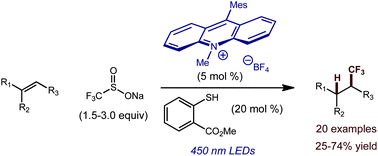Catalytic hydrotrifluoromethylation of styrenes and unactivated aliphatic alkenesvia an organic photoredox system†
Abstract
Herein is presented a direct method for the metal-free hydrotrifluoromethylation of

* Corresponding authors
a
Department of Chemistry, University of North Carolina at Chapel Hill, Chapel Hill, NC 27599-3290, USA
E-mail:
nicewicz@unc.edu
Web: http://www.chem.unc.edu/people/faculty/nicewicz/
Herein is presented a direct method for the metal-free hydrotrifluoromethylation of

 Please wait while we load your content...
Something went wrong. Try again?
Please wait while we load your content...
Something went wrong. Try again?
D. J. Wilger, N. J. Gesmundo and D. A. Nicewicz, Chem. Sci., 2013, 4, 3160 DOI: 10.1039/C3SC51209F
To request permission to reproduce material from this article, please go to the Copyright Clearance Center request page.
If you are an author contributing to an RSC publication, you do not need to request permission provided correct acknowledgement is given.
If you are the author of this article, you do not need to request permission to reproduce figures and diagrams provided correct acknowledgement is given. If you want to reproduce the whole article in a third-party publication (excluding your thesis/dissertation for which permission is not required) please go to the Copyright Clearance Center request page.
Read more about how to correctly acknowledge RSC content.
 Fetching data from CrossRef.
Fetching data from CrossRef.
This may take some time to load.
Loading related content
